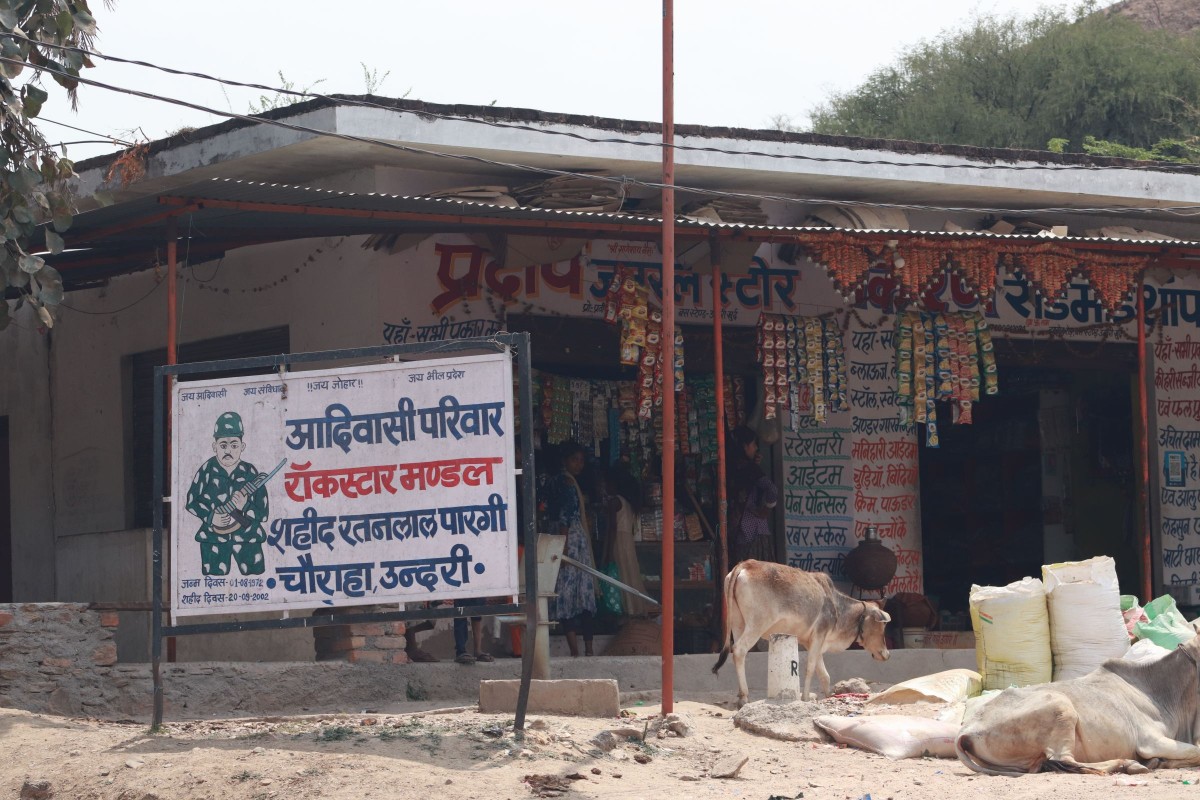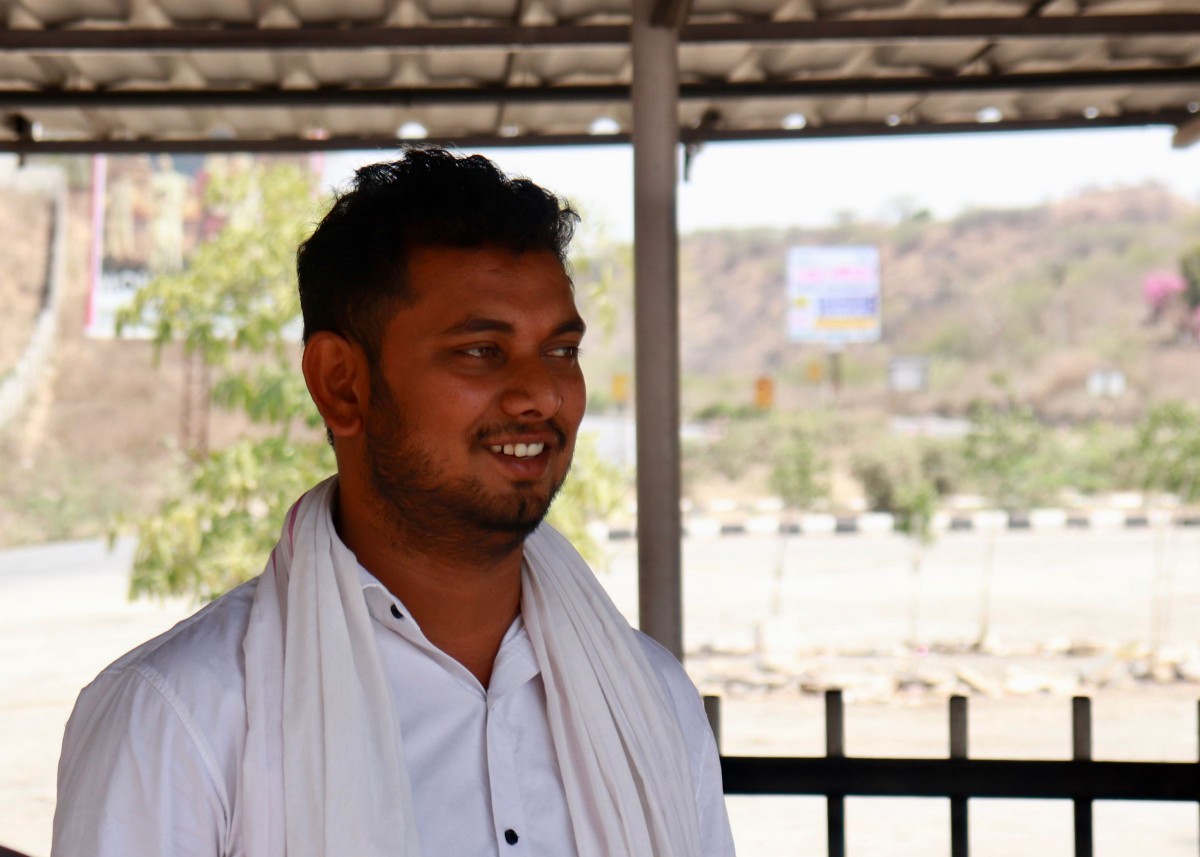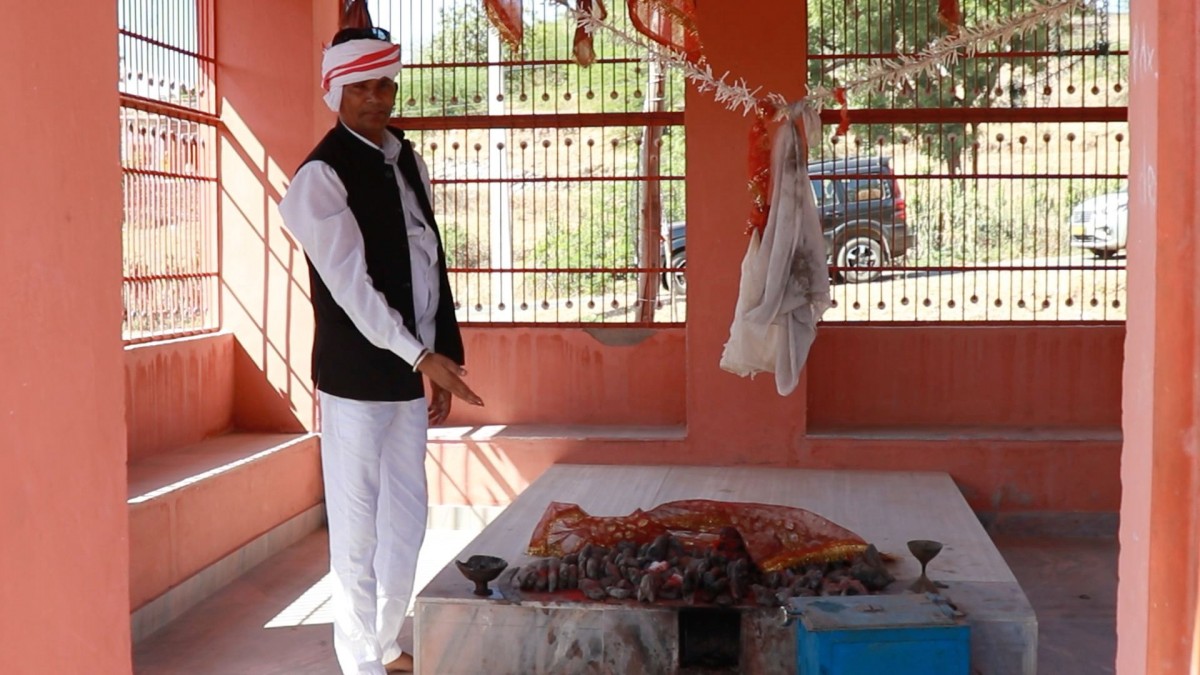Bharat Adivasi Party: Battling BJP’s Hindutva, One Election at a Time
Dungarpur-Banswara (Rajasthan): In Rajasthan the elections are done, the EVMs are under close watch awaiting counting. But some changes do not stop with the elections; neither did they begin with them. In the southernmost Adivasi region of this traditionally bipolar state, the challenge to the deeply communal politics of the BJP and the opportunism of the Congress is building up election by election.
When members of the Adivasi Parivar, an ideological group that emerged from Adivasi student politics in 2015, first entered electoral politics, few had heard of them. They contested nine seats in the 2018 assembly elections under the banner of the Bharatiya Tribal Party which had emerged in neighbouring Gujarat. Six years later, after splitting from the BTP, the new Bharat Adivasi Party (BAP) has become a national headline. Across the constituency of Dungarpur-Banswara, the visual imagery tells its own story.
At a bus stop, a group of children in their school uniforms sit on a bench posing for a picture. Behind them is a picture of Bhilu Rana or Rana Punja, a 16th-century Bhil warrior who is said to have fought alongside Rana Pratap, put up by the Adivasi Parivar.

A group of students gathered at a bus stop. Photo: Ananta Jain
A few kilometres away, at the Chokaodia bus stand, there is another poster of Bhilu Rana by the Adivasi Parivar.
What is the Adivasi Parivar, I ask them, and the response is immediate: “BAP.”
On the side of the road, the group has also put up a picture of a martyred jawan named Ratan Lal Pargi. The landscape is dotted with the iconography of tribal martyrs and symbols erected by the BAP.

An image of martyred jawan Ratan Lal Paragi. Photo: Ananta Jain
In sharp contrast, looming over a bend on an undulating road, is a billboard of Narendra Modi, dressed as an ascetic, pilgrim or priest, with the words “Aastha se khilwar nahee (No playing around with faith”. It conveys the thrust of the BJP’s campaign here.
Further along the road, near the entrance of a village, a double-storey brightly painted building stands out among smaller homes and huts. A generic Ram-Ayodhya flag flies from the building and a local village shop. Standing out, a few of the smaller dwellings bear either the Adivasi Parivar flag or the banner of the Bharat Adivasi Party.

Contrasting flags in the village. Photo: Ananta Jain
The most striking image, though, is of a majestic tree, framed by the rolling Aravallis in the background with a word hung in coloured letters shaped out of wire, that spells “Johar”, a salutation used by tribal communities.
Amit Kharadi, 28, smiles as he sees us taking pictures, “For generations they coloured us in saffron, but no more, our roots are stronger.”
In the past few months, Kharadi and his team have been campaigning for the BAP candidate from the Udaipur Lok Sabha constituency. In 2023, Kharadi contested the assembly elections from Udaipur Rural. Victory was never in sight but he more than fulfilled his aim – of establishing a presence in a BJP stronghold.
In village after village, Kharadi is recognised. Old women come to bless him, young girls shake his hand, then giggle, and a group of men help him campaign.

Amit Kharadi. Photo: Ananta Jain
“You’re just 15 kilometres from Udaipur, did you ever think you’d see the influence and popularity of our work and ideology?” he asks.
This is remarkable. Tribal communities in Udaipur, also a reserved constituency, have for decades been influenced by the RSS’s Vanvasi Kalyan Parishad (VKP), which has set up schools that have systematically worked to assimilate the Adivasis into the Hindu fold.
“They keep putting saffron flags on our icons, we keep throwing them off,” says Karadi.
In August 2012, the Bhils had staged a massive protest in Udaipur ,accusing the BJP of hoisting a saffron flag on a statue of Rana Punja. The Adivasi Parivar projects Bhilu Rana as a great warrior who had fought many battles, but stay away from the BJP’s attempts to cast these battles as struggles between Hindus and Muslims. They also take umbrage at attempts to claim a Rajput identity for Bhilu Rana.
Till the BAP established a foothold, the VKP’s work had kept this region clear of independent tribal formations, such as the Gondwana Gantantra Party in Madhya Pradesh and Chhattisgarh. The Bhils were seen as “saffronised tribals”, whether they voted the BJP or the Congress.
"I’ve voted for the BJP twice, earlier always for the Congress, but ever since my son joined BAP and I realised why, my vote will go to them,” says 75-year-old Bana Ram Bhil from Chanbora village. “This is our land and yet it is never in our name,” he adds, echoing the BAP’s key campaign thrust – ownership of land by the region’s Adivasis.
Also read: How an Adivasi Party is Changing Political Equations in Southern Rajasthan's Tribal Districts
At Undari Khurd villge, Kishan Pargi, a young lawyer, the first in his village to have done graduate studies, summarises the political thinking among his people: “Earlier, we saw the symbol of the hand and simply voted for it. Then came Modiji. Even if you nominate a donkey as a candidate, people will see Modji and vote BJP. BAP has upturned that.” Along with the influence of “Hindu dharma”, Pargi says there were some appealing schemes such as the PM’s Awaas Yojana but they did not materialise on the ground.
Pargi points to a small hut on a hill top with a little field surrounding it. “Bhils have a small home and then farm the land around it. The PM Awaas Yojana reaches just a few; when it does, it only gives us land to build a room, maybe a kitchen, but we don’t own the land around it. The Van Vibhag (Forest Department) and the government acquire it.”

The field described by Kishan Pargi. Photo: Ananta Jain
Land, both emotively and materially, is a powerful issue. Karadi says it has taken them years to go village to village explaining the importance of owning it, “We want to win elections, of course, but we also have to ensure our cadre is strong so that it can take our message to the people, it takes patience and maybe several election losses.”
No one understands the need for patience better than Kanti Roat, a founding member of the Rajasthan wing of what was then the BTP. I first met him in 2018 when he was helping his colleagues contest the assembly elections while planning his own election debut from the tribal Dungarpur-Banswara Lok Sabha seat.
At the time, we had followed his campaign trail. Given the lack of funds and resources, he and his supporters, on motorcycles, seemed like an unlikely challenge to the Congress or the BJP. But the BAP’s resonance on the ground was palpable, so much so that even then, the candidates from both these parties spent more time abusing the new formation than they did each other.
In several villages, Kanti would stop to show us evidence of what he called the erosion of tribal culture – saffron flags, Gita schools, new temples with the pantheon of mainstream Hindu deities, women in ghunghat. “Generations earlier, we’re told Adivasi women didn’t cover their heads. We will have to shift things gently but for us our work goes beyond elections.”
It is this cadre-like quality that empowers the BAP to take on the RSS. BAP’s members have a counter to every Hindutva theme spun by the BJP and the RSS. “We don’t have resources for big rallies, we do something more effective – meetings starting from the fala level, going up to the panchyat, mandal, block and zila.” Anticipating our need for an explanation, he added that a fala is a “gaon ka tukra (a piece of a village)”.
In 2018, the BTP hit national headlines, when Rajkumar Roat won the Chorasi seat and Ram Prasad Dindor won Sagwara. Kanti Roat managed to secure more than two lakh votes in the 2019 Lok Sabha from Dugarpur-Banswara.
We returned, five years later, in November 2023, shortly before assembly elections in the state. “Have you come to check if I’ve secretly joined the BJP or am BJP’s B team,” Kanti asked jokingly, referring to the allegation by local Congress leaders.
There was then talk in the air of a possible Congress-BAP alliance, but it didn’t go through.

Illustration: Pariplab Chakraborty
BAP’s view of the Congress is hardly flattering. Politically, unlike the BJP, the Congress is not anathema to them but on the ground, they feel there is little to separate the Congress’s tribal leadership from the Hindutva brigade.
Kanti repeated what he had told us earlier, “Remember, this Hinduisation has occurred as much under the BJP as during Congress terms.” He spoke of how the Congress and the BJP came together to defeat BAP members in panchayat election and by-elections.
Much had happened in the past five years since we’d been there. Kanti had a near-fatal car accident which had left him bedridden for more than a year. When the BAP split from the BTP, they had to battle the Election Commission to get themselves registered, and then fight again for a symbol.
Their first choice, a plough and a farmer, was rejected. They finally settled for a hockey stick, a symbol which connects them to their beloved hero, an icon of Adivasi communities, Jaipal Munda, who was the captain of India’s hockey team and the only Adivasi in the Constituent Assembly of India.
Munda’s electrifying speeches in the Assembly are a reminder of how the Indian State has failed to keep the promises it made to Adivasi communities. “The tragedy is the decades of BJP-Congres rule has stuffed our people’s head with bhagwa nonsense, our own people have forgotten Munda. We first had to tell them about him and then explain the symbol so they can vote for BAP.”
Once again, we followed Kanti across a stretch of Dungarpur, remote villages, spread out and sparsely inhabited, typical of Bhil settlements. He stopped at a shop to buy us three flags, one white, one red and one black, each replete with the symbolism of colour. These are our “dharm jhandas”, he explained before quoting Jaipal Munda’s speech in the Constituent Assembly to us, “Our people have their own flags, each village has one and no one can challenge it. We honour two flags, one which is our ancient Adivasi flag, the other which is the flag of India.”
At another village, Kanti took us inside a shrine, pointing to a series of stone idols, “These are our traditional deities but look at the walls of the shrine, a man from this village joined the police, thought he’d become an important Hindu and coloured the walls saffron.”

Kanti Lal at the Adivasi Temple. Photo: Ananta Jain
In conversations in the villages, while there was consensus on issues related to ownership of land, cultural issues led to greater debates. In Amliya Fala village, an elderly woman asks if it is alright for them to put up Ram flags. Gently, Kanti tells her she should do what she believes in, then engages her in a discussion of their own mythological stories.
Even political rivals seem influenced by the BAP. In Udaipur city, I met a prominent BJP Bhil leader from a political family who was in the running for a ticket. He admitted to a disillusionment with the party, saying that when it comes to ticket distribution, the BJP picks Bhil candidates who are willing puppets. This seemed to be as much about his personal disappointment as it was from an admiration for BAP, which he expressed openly. He did ask for his name to be withheld.
Also read: Real Target of Modi’s Banswara Speech Was Idea of Equitable Distribution of Wealth
In the 2024 elections, BAP has contested six seats in Rajasthan, a total of 20 seats nationally. The MLA from Chorasi, Rajkumar Roat, one of BAP’s founding member, is a serious contender from Dungarpur-Banswara. Roat has not had it easy. When he filed his nomination on a camel, a case against cruelty to animals was registered against him. As his campaign picked up, on the last day of nominations, two independent candidates, also called Rajkumar Roat, filed their candidature.
“You know who is behind this, this smells of Malviya and his likes,” Roat told us, referring to Mahendra Jeet Singh Malviya. Once the Congress’s most prominent face in the region, Malviya switched to the BJP shortly before the 2024 elections and fought the Banswara Lok Sabha seat on a BJP ticket.

Rajkumar Roat. Photo: Facebook/Rajkumar Roat
This was compounded by the Congress’s spectacularly embarrassing and ineffectual attempts to have an alliance with BAP. For a fortnight leading up to the last day for withdrawing nominations, journalists had to keep changing the stories they were filing – from an alliance which was on, then off. A Congress candidate even filed his nomination. Twenty-four hours later, the Congress was back in an alliance with BAP.
But as the last hour to withdraw nominations neared, the Congress was unable to get their candidate, Amit Damor, to withdraw. Damor fought the elections on the Congress symbol while his party supported Roat. For BAP supporters, such confusion has deepened a sense of unease with a party they feel will never see them as an equal.
Irrespective of Congress support, or whether he is able to secure a victory, Rajkumar Roat’s candidature has displayed BAP’s strength in the region. It has even forced Prime Minister Narendra Modi to come to Banswara. BAP supporters claim his visit came on the back of extensive rumour-mongering by the BJP, “They’ve gone around telling people, tribal and non-tribal, that if the BAP comes to power then we will give their daughters to Muslims. They have vilified Muslims, they are demonising tribals, but we will turn the tide.”
It is no surprise that this is where Modi chose to deliver his now infamous speech about Muslims. Despicable as it was, it should count as his tribute to the strength of the BAP.
This article went live on April twenty-seventh, two thousand twenty four, at zero minutes past five in the evening.The Wire is now on WhatsApp. Follow our channel for sharp analysis and opinions on the latest developments.




